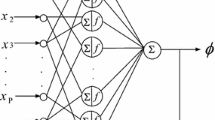Abstract
The deep feedback group method of data handling (GMDH)-type neural network is applied to the medical image analysis of MRI brain images. In this algorithm, the complexity of the neural network is increased gradually using the feedback loop calculations. The deep neural network architecture is automatically organized so as to fit the complexity of the medical images using the prediction error criterion defined as Akaike’s information criterion (AIC) or prediction sum of squares (PSS). The recognition results show that the deep feedback GMDH-type neural network algorithm is useful for the medical image analysis of MRI brain images, because the optimum neural network architectures fitting the complexity of the medical images are automatically organized so as to minimize the prediction error criterion defined as AIC or PSS.



























Similar content being viewed by others
Explore related subjects
Discover the latest articles, news and stories from top researchers in related subjects.References
Kondo T, Ueno J, Takao S (2015) Medical image diagnosis of liver cancer by hybrid feedback GMDH-type neural network using principal component-regression analysis. Artif Life Robot 20:145–151
Kondo T, Ueno J, Takao S (2015) Deep multi-layered GMDH-type neural network using principal component-regression analysis and its application to medical image recognition of brain and blood vessels. In: Proceedings of the 20th international symposium on artificial life and robotics 2015, pp 339–342
Kondo T (1998) GMDH neural network algorithm using the heuristic self-organization method and its application to the pattern identification problem. In: Proceedings of the 37th SICE annual conference, pp 1143–1148
Farlow SJ (ed) (1984) Self-organizing methods in modeling, GMDH-type algorithm. Marcel Dekker, Inc., New York
Ivakhnenko AG (1970) Heuristic self-organization in problems of engineering cybernetics. Automatica 6(2):207–219
Anderson VM, Schott JM, Bartlett JW, Leung KK, Miller DH, Fox NC (2012) Gray matter atrophy rate as a marker of disease progression in AD. Neurobiol Aging 33(7):1194–1202
Mouton PR, Martin LJ, Calhoun ME, Dal Fomo G, Price DL (1998) Cognitive decline strongly correlates with cortical atrophy in Alzheimer’s dementia. Neurobiol Aging 19(5):371–377
Serra L, Cercignani M, Lenzi D, Perri R, Fadda L, Caltagirone C, Macaluso E, Bozzali M (2010) Gray and white matter changes at different stages of Alzheimer’s disease. J Alzheimer’s Dis 19(1):147–159
Anderson VM, Femando KT, Davies GR, Rashid W, Frost C, Fox NC, Miller DH (2007) Cerebral atrophy measurement in clinically isolated syndromes and relapsing remitting multiple sclerosis: a comparison of registration-based methods. J Neuroimaging 17(1):61–68
Akaike H (1974) A new look at the statistical model identification. IEEE Trans Automatic Control AC-19(6):716–723
Tamura H, Kondo T (1980) Heuristics free group method of data handling algorithm of generating optimum partial polynomials with application to air pollution prediction. Int J Syst Sci 11(9):1095–1111
Rumelhart DE, Hinton GE, Williams RJ (1986) Learning representations by back-propagation errors. Nature 323(9):533–536
Zurada JM (1992) Introduction to artificial neural systems. PWS Publishing Company, Boston
Pham DT, Xing L (1995) Neural networks for identification, prediction and control. Springer, London
Hinton GE, Osindero S, Teh YW (2006) A fast learning algorithm for deep belief nets. Neural Comput 18(7):1527–1554
Hinton GE, Salakhutdinov R (2006) Reducing the dimensionality of data with neural networks. Science 313:504–507
Draper NR, Smith H (1981) Applied regression analysis. Wiley, New York
Acknowledgements
This work was supported by (JSPS) KAKENHI 26420421.
Author information
Authors and Affiliations
Corresponding author
Additional information
This work was presented in part at the 21st International Symposium on Artificial Life and Robotics, Beppu, Oita, January 20-22, 2016.
About this article
Cite this article
Takao, S., Kondo, S., Ueno, J. et al. Deep feedback GMDH-type neural network and its application to medical image analysis of MRI brain images. Artif Life Robotics 23, 161–172 (2018). https://doi.org/10.1007/s10015-017-0410-1
Received:
Accepted:
Published:
Issue Date:
DOI: https://doi.org/10.1007/s10015-017-0410-1




